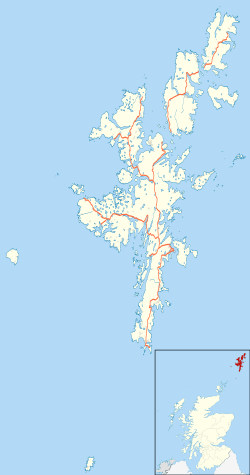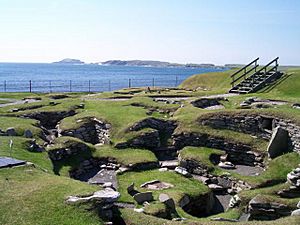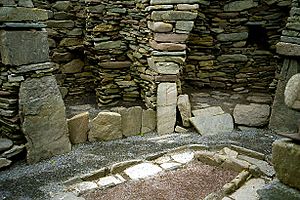Jarlshof facts for kids
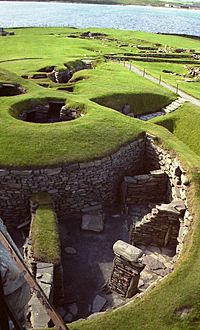
Jarlshof, February 2007
|
|
| Location | Mainland, Shetland, Scotland |
|---|---|
| Coordinates | 59°52′10″N 1°17′28″W / 59.8693725°N 1.2910305°W |
| Type | Roundhouses, broch, wheelhouses, longhouse |
| History | |
| Periods | Bronze Age Iron Age, Pictish, Norse |
| Site notes | |
| Ownership | Historic Scotland |
Jarlshof is an amazing ancient site in Shetland, Scotland. It's like a time capsule, showing how people lived for thousands of years! This special place is in Sumburgh, on the main island of Shetland. Experts call it "one of the most remarkable archaeological sites" in the British Isles.
At Jarlshof, you can see remains from as far back as 2500 BC, all the way up to the 1600s AD. Imagine, people lived here during the Bronze Age, Iron Age, Pictish times, and the Viking Age. Each group left behind their homes and tools. The most noticeable buildings today are from a Scottish manor house. This house inspired the name "Jarlshof," which means "Earl's Mansion." A famous writer, Walter Scott, gave it this name in a book in 1821.
Today, Historic Scotland looks after Jarlshof. You can visit it almost all year round. In 2012, Jarlshof, along with Mousa and Old Scatness, was suggested as a World Heritage Site. This shows how important these ancient places are!
Contents
Where is Jarlshof and What Does its Name Mean?
Jarlshof is located at the very southern tip of the Shetland Mainland. It's close to the villages of Sumburgh and Grutness. It's also near the south end of Sumburgh Airport. The site looks out over a part of the sea called the West Voe of Sumburgh.
People probably chose this spot because it had fresh water and building materials from the beach. The southern Mainland also has good land for farming in Shetland. There are many other ancient settlements nearby, like Scatness, which is only a mile away. Scatness also has old brochs and ruins. Jarlshof has a small visitor center where you can see displays and ancient objects.
The name Jarlshof means "Earl's Mansion." It was made up by the writer Walter Scott. He visited the site in 1814. He based the name on how people in Scotland called a rich landowner's house. It took over a hundred years for archaeologists to find proof that Vikings actually lived there. But there's no evidence that a Norse jarl (a Viking chief) ever lived in the manor house.
A Look Through Time: Jarlshof's History
The buildings at Jarlshof show thousands of years of people living there. It's like a mini-history book of Shetland. Most of the site was hidden until a big storm in the late 1800s. The storm washed away part of the shore, revealing the old buildings.
Archaeologists started digging properly in 1925. They soon found items from the Bronze Age. Jarlshof was one of the first ancient tower sites (brochs) to be dug up using modern science. This happened between 1949 and 1952. These digs showed many layers of buildings from different times.
The buildings found include a smithy from the Bronze Age. There's also an Iron Age broch (a tall, round stone tower). You can also see roundhouses, Pictish wheelhouses, a Viking longhouse, and a mediaeval farmhouse. No new big digs have happened since the early 1950s.
Early Life: The Neolithic Period
The very first things found at Jarlshof are pieces of pottery from the Neolithic era. This was a time when people first started farming. While the main settlement began later, a nearby site shows people lived in the area around 3200 BC.
The Bronze Age: Around 2000 BC to 800 BC
The Bronze Age in Scotland lasted from about 2000 BC to 800 BC. The oldest buildings at Jarlshof are from this time. However, there's proof people lived here even earlier, around 2500 BC. You can see the remains of several small, oval houses with thick stone walls. These houses are similar to those at Skara Brae in Mainland, Orkney, but they are smaller and from a later time. These early homes might have been partly underground. This helped make them strong and kept them warm.
Archaeologists also found signs of a cattle stall. It had a channel to carry waste to a tank in a courtyard. A whale bone was even used as a post to tie up animals! Broken molds from a smithy show that people made axes, knives, swords, and pins here. A bronze dagger was also found. This tells us the smith was skilled in an Irish style of metalwork. Bone pins and tools were also found. A very special bone "plaque" was discovered. It's about 5 centimeters (2 inches) long, has three holes, and is decorated with patterns. No one knows what it was used for! After the Bronze Age, a layer of clean sand covers these buildings. This suggests people stopped living here for a while.
The Iron Age and Pictish Times
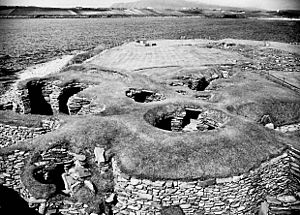
People in the Iron Age built their homes right on top of the Bronze Age settlement. They built a complex roundhouse, which was later replaced by a different kind of roundhouse. We don't have exact dates for these, but tools found suggest the later roundhouse was built before 200 BC.
This is also when the broch was built. A broch is a tall, round stone tower. Part of Jarlshof's broch has been lost to the sea, so modern sea walls protect it now. The tower was probably over 13 meters (40 feet) tall. Like other brochs, it had great views of the sea. Many Iron Age sites in Shetland have defenses, and Jarlshof is no different. A strong outer wall around the broch once had a house and a barn. This wall was later used to build a large roundhouse next to the broch.
The oldest part of the wheelhouse complex dates back to 200 BC. Other parts were built later. Wheelhouses are round buildings with stone pillars inside, like spokes on a wheel. The Jarlshof wheelhouses are some of the best examples of their kind. They were built in three stages. The best-preserved one still has much of its stone roof. It shows many arched sections between the pillars. Another wheelhouse was built as a circle, and the pillars were added later. This might have been an earlier, less stable design. Unlike many wheelhouses elsewhere, which were built into the ground, Jarlshof's seem to have been built from the ground up.
From the later Pictish period, archaeologists found a bone pin. It had a round head and was likely used for hair or clothing. It dates from AD 500–800. "Painted pebbles" are found at many Pictish sites. One was found at Jarlshof. It's a rectangular piece of slate with a cross painted on it. It also has two S-shaped swirls, which might link it to early Christian beliefs. One of only two Pictish symbol stones found in Shetland was also here. It shows a double disc shape and a Z-rod symbol. Pottery from this time includes bowls with flat edges. The quality of the pots seemed to get worse before the Vikings arrived.
Ancient Roman writers mentioned islands they called Haemodae and Acmodae in AD 43 and 77. These are thought to be Shetland. Another early mention of Shetland might be when Tacitus wrote about the Roman fleet seeing "Thule" in AD 98. Some believe Tacitus was talking about southern Shetland, possibly the area around the brochs at Jarlshof.
The Norse Period: Vikings in Shetland
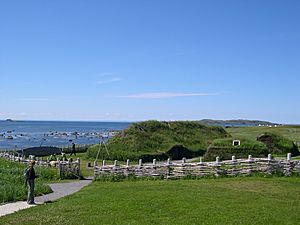
Buildings from the Viking Age once covered most of the Jarlshof site. It's believed that Norse people lived here continuously from the 800s to the 1300s. Digs in the 1930s found the first confirmed Norse longhouse in the British Isles. Later digs in the 1950s found proof of fishing and farming.
People kept sheep, cattle, pigs, and ponies. They ate fish like Atlantic cod, saithe, and ling. Bones from whales and seals were also found, along with one dog. Chicken bones are rare from this time.
There are seven Norse-era houses at Jarlshof. But only two were used at any one time. There were also several smaller buildings. One small square building with a large fireplace might have been a sauna. It was later replaced by two other small buildings. The largest house from this time is a 20 by 5 meter (65 by 16 foot) rectangular room. It had doors on opposite sides, wooden benches along the long walls, and a fireplace in the middle.
Unlike earlier buildings with cone-shaped thatched roofs, Norse buildings had ridged wooden roofs. Later, this large building was also used to shelter farm animals. It had a paved center and stalls for animals. Even later, it might have become an outbuilding. One barn door puzzled archaeologists because it seemed too narrow for a cow. The mystery was solved when a similar barn door was found on another island, Unst. It was narrow at the bottom but widened out to fit a cow. Another small building is thought to have been a room for drying corn. Later houses were built at a right angle to the longhouse. These are similar to the small farmhouses (crofts) common in Shetland until the mid-1800s.
One hundred and fifty loom weights were found. This suggests that wool was very important to Norse life. Fishing weights from later in the Norse period show that people also fished in deep waters. Jarlshof also had many iron tools, like shears, scissors, sickles, a fish-hook, and a knife. The iron came from local "bog iron." Hazel, birch, and willow trees grew nearby. But pine and oak wood must have been driftwood or brought in from elsewhere.
Drawings scratched on slate were found. They show ships with dragon heads, pictures of an old man, a young bearded man, and a four-legged animal. These drawings were found in Viking layers but look like Pictish art. This might mean they were made before the Vikings arrived, or that art styles continued from one period to the next. Also, even though Norse buildings are rectangular and Pictish ones are round, the bottom parts of the walls were built in the same way. Viking-style loom weights and other items were found with stone discs that had Pictish designs. A bronze-gilded harness piece made in Ireland in the 700s or 800s was also found. Many items from this period are now in the Shetland Museum. Jarlshof has the most complete Viking site you can see anywhere in Britain.
The Old House of Sumburgh: A Scottish Manor
The castle, now called Jarlshof House, was built during the Scottish period. It started as a medieval stone farmhouse. In the 1500s, it was turned into a fortified house by Robert Stewart, 1st Earl of Orkney. This happened after Scotland took control of Shetland. At this time, it was called "New Hall."
His son, Patrick Stewart, 2nd Earl of Orkney, updated it in the early 1600s. He renamed it the "Old House of Sumburgh." Later, it belonged to John Buchanan and Margaret Hartsyde. But it was left empty in the late 1600s. The building was also known as "The laird's house" and "Stewart Mansion."
Other Interesting Places to See
Shetland
Other Ancient Sites
- Prehistoric Scotland
- Timeline of prehistoric Scotland
- Prehistoric Orkney
- Brough of Birsay – a similar ancient site in Orkney
- Oldest buildings in the United Kingdom


